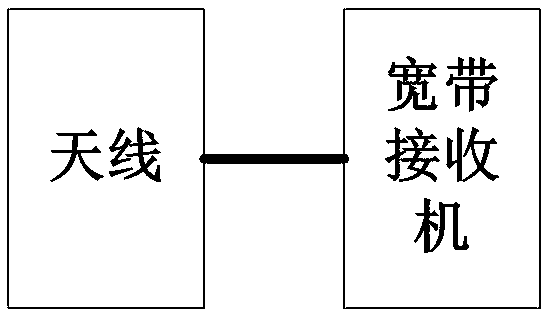Ad Hoc network virtual backbone node identification system
A backbone node and identification system technology, applied in the field of communication, can solve problems such as the inability to identify AdHoc network backbone nodes, and achieve the effects of improving information processing capabilities, saving manpower and costs, and improving receiving strength
- Summary
- Abstract
- Description
- Claims
- Application Information
AI Technical Summary
Problems solved by technology
Method used
Image
Examples
Embodiment 1
[0075] A specific embodiment of the present invention discloses an Ad Hoc network virtual backbone node identification system, such as figure 1 As shown, it includes a receiving unit, a signal processing unit, a network physical topology inference unit and a backbone node identification unit connected in sequence, and the four are integrated and installed on the vehicle platform.
[0076] The receiving unit is used for receiving signals in the working frequency band of the Ad Hoc network.
[0077] The signal processing unit is used to preprocess and detect the signals in the working frequency band of the above-mentioned Ad Hoc network, identify the nodes in the Ad Hoc network, and locate the nodes in the Ad Hoc network by radio positioning methods, and obtain the number of nodes and node position information and node deployment area size.
[0078] The network physical topology inference unit is used to obtain the important communication distance according to the above-mention...
Embodiment 2
[0087] Optimizing on the basis of Example 1, such as figure 2 As shown, the receiving unit includes an antenna and a wideband receiver connected in sequence.
[0088] The wideband receiver is used to receive the signals in the working frequency band of the Ad Hoc network through the antenna, and transmit the received signals in the working frequency band of the Ad Hoc network to the signal processing unit. Wherein, through the antenna, the intensity of the received signal (the signal in the working frequency band of the Ad Hoc network) can be enhanced, and through the broadband receiver, the wide spectrum characteristic of the received signal can be realized.
[0089] Preferably, as image 3 As shown, the signal processing unit includes a preprocessing module, a node information detection device, a radio positioning device and a node information statistics device connected in sequence.
[0090] The preprocessing module is used to perform signal preprocessing on the received...
Embodiment 3
[0131] An example of the system described in the application embodiment 2 is provided below, and the technical effect of the Ad Hoc network virtual backbone node identification system is constructed by using EXata software such as Figure 6 The simulation environment shown in the test method is verified. In the simulation scenario, 40 nodes are randomly deployed using the random deployment model, and the relevant parameters are shown in Table 1.
[0132] Table 1
[0133] parameter
value
Number of nodes
40
Deployment area size
(1×1)km 2
AODV
fading value
4dB
communication frequency
2.4GHz
business type
CBR
[0134] For the size of the deployment area and the number of nodes, when setting k 1 When the value is 0.8, the network connectivity rate is close to 100%. Calculated by the important communication distance formula, R C ≈332m.
[0135] Combining node location informatio...
PUM
 Login to View More
Login to View More Abstract
Description
Claims
Application Information
 Login to View More
Login to View More - R&D
- Intellectual Property
- Life Sciences
- Materials
- Tech Scout
- Unparalleled Data Quality
- Higher Quality Content
- 60% Fewer Hallucinations
Browse by: Latest US Patents, China's latest patents, Technical Efficacy Thesaurus, Application Domain, Technology Topic, Popular Technical Reports.
© 2025 PatSnap. All rights reserved.Legal|Privacy policy|Modern Slavery Act Transparency Statement|Sitemap|About US| Contact US: help@patsnap.com



